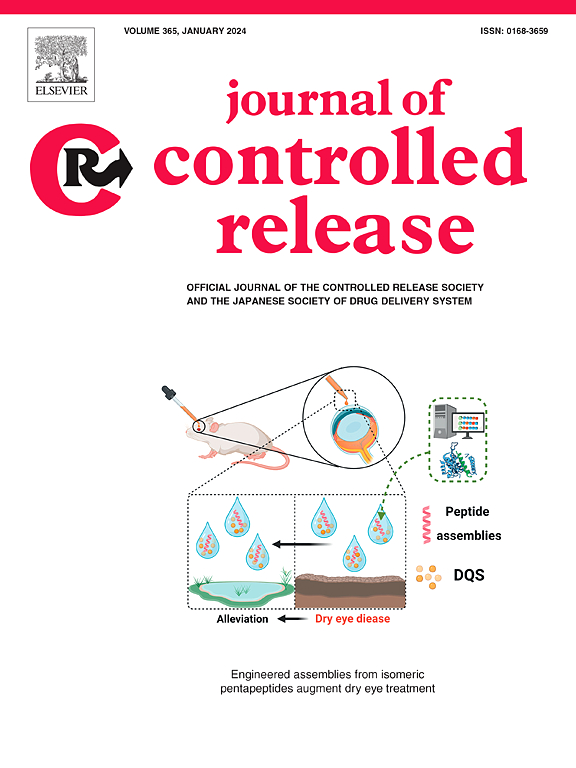Formulation development of dual-compartment topical inserts combining tenofovir alafenamide and elvitegravir for flexible on-demand HIV prevention
IF 10.5
1区 医学
Q1 CHEMISTRY, MULTIDISCIPLINARY
引用次数: 0
Abstract
Pre-exposure prophylaxis (PrEP) has emerged as a prominent approach for the prevention of HIV infections. While the latest advances have resulted in effective oral and injectable product options, there are still gaps in on-demand, event-driven, topical products for HIV prevention that are safe and effective. Here we describe the formulation development of a dual-compartment topical insert containing tenofovir alafenamide fumarate (TAF) and elvitegravir (EVG) that may be administered when needed, vaginally or rectally, pre- or post-coitus, for flexible HIV prophylaxis. Specifically, we describe the lab-scale formulation development, preclinical mucosal safety and pharmacokinetics (PK) testing in rabbits, long-term stability, and scale-up clinical manufacturing of the lead TAF/EVG (20 mg/16 mg) inserts, which are currently in clinical stages of development. As designed, the inserts are small, discreet and portable, offering a number of promising attributes, such as simple and robust direct-compression manufacturing, fast initial disintegration/dissolution, and suitable mechanical strengths showing low hardness (<8 kg), friability (<1 %), and moisture content (<1 %). The inserts initiated disintegration quickly (∼ ≤ 15 min) providing full in vitro release (>90 %) of TAF and EVG within 60 min of dissolution. The lead insert was selected from formulation prototypes that met the evaluation criteria for manufacturability and characterization, along with a dose-ranging PK study in non-human primates. Successful technology transfer for clinical development of the lead TAF/EVG (20 mg/16 mg) insert was confirmed under current Good Manufacturing Practices (cGMP) conditions. Based on the 12 months (lab-scale) and 24 months (clinical batch) stability data, the TAF/EVG inserts are projected to have a long shelf life of over 2 years, if stored at or below 30 °C/65 % RH. Overall, these newly designed topical inserts have formulation properties that enable stable storage and fast release of the antiretroviral payload from a small, portable and discreet dosage form. They are safe and effective when applied vaginally or rectally, before or after coitus, providing the basis for a new method of flexible on-demand HIV prevention for cisgender and transgender women and men. The TAF/EVG inserts are currently the most clinically advanced on-demand topical product, as attested by their completed and ongoing clinical trials.

结合替诺福韦-阿拉非那胺和埃替拉韦(Elvitegravir)的双室外用插片的配方开发,用于灵活地按需预防艾滋病。
暴露前预防疗法(PrEP)已成为预防艾滋病毒感染的重要方法。虽然最新的研究进展已经产生了有效的口服和注射产品,但在按需使用、事件驱动、安全有效的预防艾滋病外用产品方面仍存在差距。在此,我们介绍了一种含有富马酸替诺福韦-阿拉非酰胺(TAF)和埃维特拉韦(EVG)的双室外用插入物的配方开发,该插入物可在需要时经阴道或直肠、性交前或性交后给药,用于灵活的艾滋病预防。具体来说,我们介绍了实验室规模的制剂开发、临床前粘膜安全性和兔子药代动力学 (PK) 测试、长期稳定性以及目前处于临床开发阶段的 TAF/EVG (20 毫克/16 毫克)先导插入物的规模化临床生产。按照设计,这种插件体积小、不显眼且便于携带,具有许多有前途的特性,如简单而坚固的直接压缩制造、快速的初始崩解/溶解以及合适的机械强度,在溶解 60 分钟内显示 TAF 和 EVG 的低硬度(90%)。先导插入物是从符合可制造性和特性评估标准的制剂原型中挑选出来的,同时还在非人灵长类动物中进行了剂量范围 PK 研究。在 cGMP 条件下,TAF/EVG(20 毫克/16 毫克)先导插入物的临床开发技术转让获得成功。根据 12 个月(实验室规模)和 24 个月(临床批次)的稳定性数据,如果在 30 °C/65 % 相对湿度或以下条件下储存,TAF/EVG 插片的保质期预计将超过 2 年。总之,这些新设计的外用插入剂具有配方特性,能够稳定储存,并能从小巧、便携和隐蔽的剂型中快速释放抗逆转录病毒有效载荷。在性交前后,经阴道或直肠使用它们既安全又有效,为顺性和变性男女按需灵活预防艾滋病的新方法奠定了基础。TAF/EVG 插入物是目前临床上最先进的按需外用产品,已完成和正在进行的临床试验证明了这一点。
本文章由计算机程序翻译,如有差异,请以英文原文为准。
求助全文
约1分钟内获得全文
求助全文
来源期刊

Journal of Controlled Release
医学-化学综合
CiteScore
18.50
自引率
5.60%
发文量
700
审稿时长
39 days
期刊介绍:
The Journal of Controlled Release (JCR) proudly serves as the Official Journal of the Controlled Release Society and the Japan Society of Drug Delivery System.
Dedicated to the broad field of delivery science and technology, JCR publishes high-quality research articles covering drug delivery systems and all facets of formulations. This includes the physicochemical and biological properties of drugs, design and characterization of dosage forms, release mechanisms, in vivo testing, and formulation research and development across pharmaceutical, diagnostic, agricultural, environmental, cosmetic, and food industries.
Priority is given to manuscripts that contribute to the fundamental understanding of principles or demonstrate the advantages of novel technologies in terms of safety and efficacy over current clinical standards. JCR strives to be a leading platform for advancements in delivery science and technology.
 求助内容:
求助内容: 应助结果提醒方式:
应助结果提醒方式:


